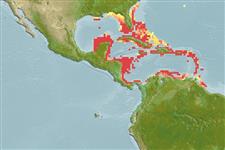Hexacorallia |
Scleractinia |
Faviidae
Environment: milieu / climate zone / depth range / distribution range
Ecology
Reef-associated; depth range 0 - 65 m (Ref. 848). Tropical; 33°N - 8°N, 92°W - 58°W (Ref. 848)
Western Atlantic: Gulf of Mexico, Caribbean to Bermuda.
Length at first maturity / Size / Weight / Age
Maturity: Lm ? range ? - ? cm
Colony: either free-living with cone-shaped undersurface, or attached. Small colonies: oval shaped, with a central axial valley with short side valleys. Larger colonies: hemispherical, meandroid. With distinct ambulacral groove along the tops of valley walls (Ref. 848).
Maximum depth from Ref. 83917. Zooxanthellate (Ref. 116012). Small and free-living colonies in subtidal seagrass beds; attached and hemispherical in shallow reef environments (Ref. 848). Also common in sand and coral rubble (Ref. 415)
Life cycle and mating behavior
Maturity | Reproduction | Spawning | Eggs | Fecundity | Larvae
Hermaphroditic (Ref. 113712). Mature gametes are shed into the coelenteron and spawned through the mouth. Life cycle: The zygote develops into a planktonic planula larva. Metamorphosis begins with early morphogenesis of tentacles, septa and pharynx before larval settlement on the aboral end (Ref. 833).
Collin, R., M.C. Díaz, J. Norenburg, R.M. Rocha, J.A. Sánchez, M. Schulze, A. Schwartz and A. Valdés 2005 Photographic identification guide to some common marine invertebrates of Bocas Del Toro, Panama. Caribbean Journal of Science. 41(3):638-707. (Ref. 415)
IUCN Red List Status
(Ref. 130435: Version 2025-1)
CITES status (Ref. 108899)
Not Evaluated
Threat to humans
Human uses
| FishSource |
Tools
More information
Trophic EcologyFood items (preys)
Diet composition
Food consumption
Predators
Population dynamicsGrowth
Max. ages / sizes
Length-weight rel.
Length-length rel.
Length-frequencies
Mass conversion
Abundance
PhysiologyOxygen consumption
Human RelatedStamps, coins, misc.
Internet sources
Estimates based on models
Preferred temperature
(Ref.
115969): 24.9 - 28.1, mean 27 (based on 188 cells).
Price category
Unknown.
